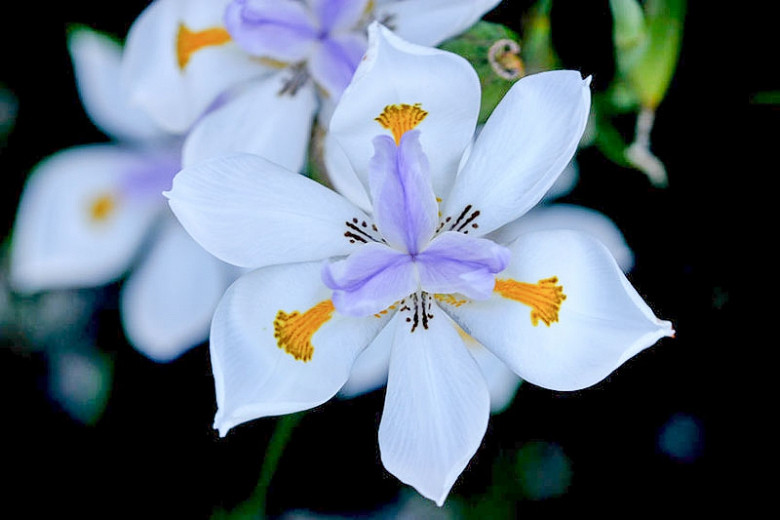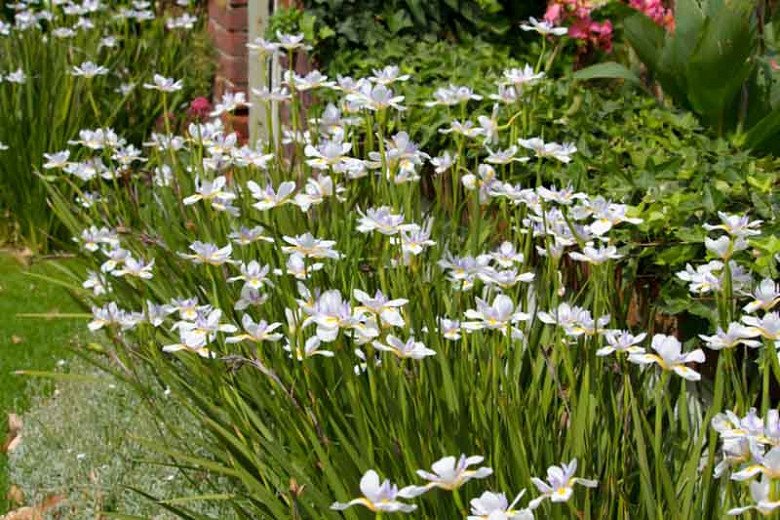Dietes grandiflora (Fairy Iris)
Native to Eastern and Southern Africa, Dietes grandiflora (Fairy Iris) is a rhizomatous evergreen perennial with large, iris-like flowers, 4 in. across (10 cm), borne on erect, slender stalks atop clumps of long, upright, stiff, sword-like green leaves. Each waxy white flower consists of 3 outer petals adorned with a stripe of rich yellow near their base, and 3 inner segments flecked with brown at their heart. Radiating from the bloom's center are 3 pale violet style arms. The flowers last up to 3 days but are quickly followed by new ones. Blooming in summer, in flushes that seem to occur at 2-week intervals, they are on display almost year-round in mild climates. This plant is occasionally called the "Fairy Iris" because the fragile white petals not only look like fairy wings but also have a tendency to disappear mysteriously overnight! A spectacular plant in mass plantings or in containers.
- Grows up to 3-4 ft. tall (90-120 cm) and 2-3 ft. wide (60-90 cm).
- Easy to grow, this plant performs best in full sun or part shade, in moist, well-drained soils. Best flower production occurs in full sun, but light afternoon shade is welcomed. It is fairly drought tolerant.
- No serious insect or disease problems.
- A welcomed addition to Mediterranean gardens, cottage gardens, and gravel gardens. Most spectacular when planted in large groupings where it develops a bouquet effect
- Remove seed pods to promote additional bloom. Flower stems should not be removed after flowering. Clip off any leaves that die. Self-sows freely; deadhead if you do not want volunteer seedlings next season.
- Propagate by seed at 13-15°C (55-59°F) in autumn or spring. Alternatively, propagate by division of rhizomes after flowering. Plants may be difficult to establish.
Requirements
| Hardiness | 8 – 11 |
|---|---|
| Heat Zones | 8 – 12 |
| Climate Zones | 8, 9, 12, 13, 14, 15, 16, 17, 18, 19, 20, 21, 22, 23, 24, H1, H2 |
| Plant Type | Perennials |
| Plant Family | Dietes |
| Exposure | Full Sun, Partial Sun |
| Season of Interest | Summer (Early,Mid,Late) |
| Height | 3' – 4' (90cm – 120cm) |
| Spread | 2' – 3' (60cm – 90cm) |
| Spacing | 36″ (90cm) |
| Water Needs | Average |
| Maintenance | Low |
| Soil Type | Chalk, Loam, Sand |
| Soil pH | Acid, Alkaline, Neutral |
| Soil Drainage | Moist but Well-Drained |
| Characteristics | Cut Flowers, Showy, Evergreen |
| Tolerance | Drought |
| Garden Uses | Beds and Borders, Patio and Containers |
| Garden Styles | City and Courtyard, Gravel and Rock Garden, Informal and Cottage, Mediterranean Garden |


